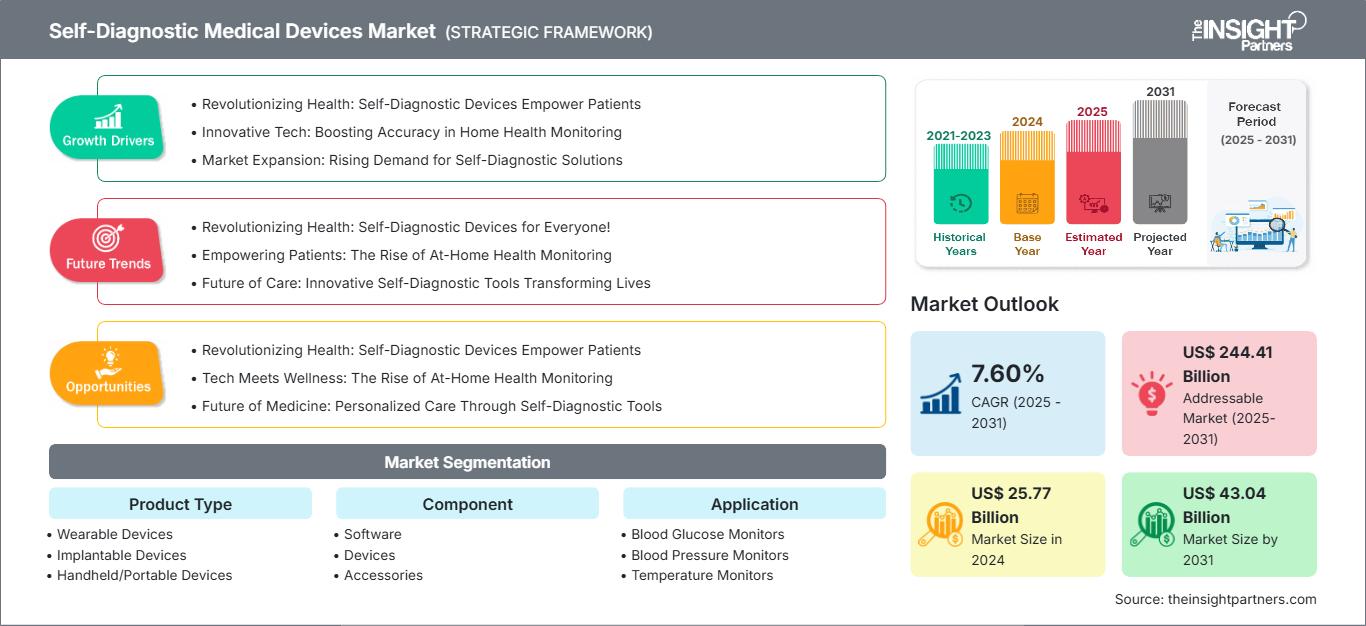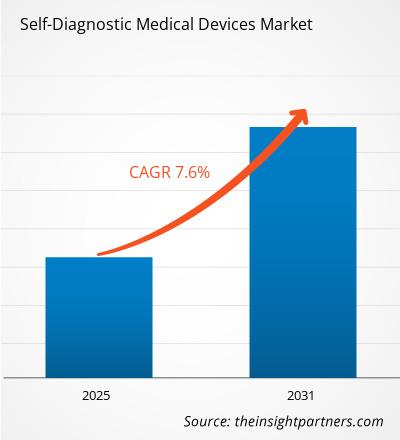预计从 2025 年到 2031 年,自我诊断医疗器械市场将以 7.60% 的复合年增长率增长,市场规模将从 2024 年的 257.7 亿美元增长到 2031 年的 430.4 亿美元。
本报告按产品类型(可穿戴设备、植入式设备、手持/便携式设备、固定式设备)进行分类,并进一步基于组件(软件、设备、配件)分析市场。此外,报告还按应用领域(血糖监测仪、血压监测仪、体温监测仪、妊娠/生育力检测试剂盒、睡眠呼吸暂停设备)和行业终端用户(家庭护理机构、康复中心)对市场进行分析。报告对每个关键细分市场均提供了全球、区域和国家层面的全面细分数据。
报告包含所有细分市场的市场规模和预测,并以美元计价。报告还提供了主要参与者当前市场地位的关键统计数据,以及对当前市场趋势和新兴机遇的深入分析。
报告目的
The Insight Partners发布的《自我诊断医疗器械市场报告》旨在描述当前市场格局和未来增长趋势,以及主要驱动因素、挑战和机遇。该报告将为各类商业利益相关者提供参考,例如:
- 技术提供商/制造商:了解不断变化的市场动态和潜在的增长机会,从而能够做出明智的战略决策。
- 投资者:对市场增长率、市场财务预测以及整个价值链中存在的机会进行全面的趋势分析。
- 监管机构:监管市场政策和执法活动,旨在最大限度地减少滥用行为,维护投资者信任和信心,维护市场的诚信和稳定。
自诊断医疗器械市场细分
产品类型
- 可穿戴设备
- 植入式医疗器械
- 手持/便携式设备
- 固定设备
成分
- 软件
- 设备
- 配件
应用
- 血糖监测仪
- 血压监测仪
- 温度监测器
- 怀孕/生育力测试试剂盒
- 睡眠呼吸暂停设备
最终用户
- 家庭护理机构
- 康复中心
您可以免费获得任何报告的定制服务,包括本报告的部分内容、国家/地区层面的分析、Excel 数据包,以及面向初创企业和高校的优惠折扣。
自诊断医疗器械市场:战略洞察

-
获取本报告的主要市场趋势。这份免费样品将包含数据分析,内容涵盖市场趋势、估算和预测等。
自诊断医疗器械市场增长驱动因素
- 医疗健康革命:自我诊断设备赋能患者
- 创新技术:提升家庭健康监测的准确性
- 市场扩张:对自我诊断解决方案的需求不断增长
自诊断医疗器械市场未来趋势
- 革新健康:人人都能使用的自我诊断设备!
- 赋能患者:居家健康监测的兴起
- 未来医疗:创新型自我诊断工具改变生活
自诊断医疗器械市场机遇
- 医疗健康革命:自我诊断设备赋能患者
- 科技与健康融合:居家健康监测的兴起
- 医学的未来:通过自我诊断工具实现个性化医疗
自诊断医疗器械市场区域洞察
The Insight Partners 的分析师对预测期内影响自我诊断医疗器械市场的区域趋势和因素进行了详尽的阐述。本节还探讨了北美、欧洲、亚太、中东和非洲以及南美和中美洲等地区的自我诊断医疗器械市场细分和地域分布情况。
自诊断医疗器械市场报告范围
| 报告属性 | 细节 |
|---|---|
| 2024年市场规模 | 257.7亿美元 |
| 到2031年市场规模 | 430.4亿美元 |
| 全球复合年增长率(2025-2031年) | 7.60% |
| 史料 | 2021-2023 |
| 预测期 | 2025-2031 |
| 涵盖部分 |
按产品类型
|
| 覆盖地区和国家 |
北美
|
| 市场领导者和主要公司简介 |
|
自诊断医疗器械市场参与者密度:了解其对业务动态的影响
受终端用户需求不断增长的推动,自我诊断医疗器械市场正快速发展。终端用户需求增长的驱动因素包括消费者偏好的转变、技术的进步以及消费者对产品益处的认知度提高。随着需求的增长,企业不断拓展产品和服务,持续创新以满足消费者需求,并把握新兴趋势,这些都进一步推动了市场增长。

- 获取自我诊断医疗器械市场主要参与者概览
主要卖点
- 全面覆盖:该报告全面分析了自我诊断医疗器械市场的产品、服务、类型和最终用户,提供了全面的市场概况。
- 专家分析:该报告是根据行业专家和分析师的深入理解编制的。
- 最新信息:该报告涵盖了最新的信息和数据趋势,确保了其与业务的相关性。
- 定制选项:本报告可根据客户的具体需求进行定制,并能恰当地适应业务战略。
因此,这份关于自我诊断医疗器械市场的研究报告有助于深入了解和解读行业现状及增长前景。尽管其中可能存在一些合理的担忧,但总体而言,这份报告的优势远大于劣势。
- 历史分析(2 年)、基准年、预测(7 年)及复合年增长率
- PEST和SWOT分析
- 市场规模、价值/数量 - 全球、区域、国家
- 行业和竞争格局
- Excel 数据集
近期报告
客户评价
购买理由
- 明智的决策
- 了解市场动态
- 竞争分析
- 客户洞察
- 市场预测
- 风险规避
- 战略规划
- 投资论证
- 识别新兴市场
- 优化营销策略
- 提升运营效率
- 顺应监管趋势






















 获取免费样品 - 自我诊断医疗器械市场
获取免费样品 - 自我诊断医疗器械市场